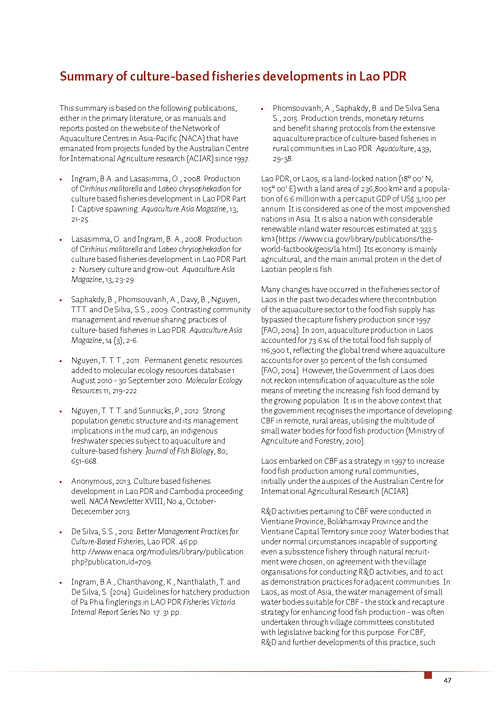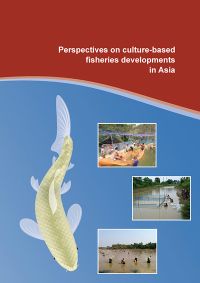Challenges and constraints for developing CBF in Cambodia and a possible strategy for success
12 May 2015 | Sena De Silva and L.S. Song | 1361 Downloads | .pdf | 1.72 MB | Cambodia, Culture-based fisheries, Inland aquaculture
Fish is the most important source of animal protein in Cambodia. On average it makes up more than 75 % of animal protein and in some areas of the country aquatic resources make up 80 % of the available animal protein. Overall, fish consumption is estimated to be around 63 kg/caput/year (FiA, 2013) (whole fish equivalent) and is many times greater than the global average, reflecting the importance of the fisheries sector to the diet and culture of Cambodian people.
The application of culture-based fisheries in Cambodian waters commenced with the initiation of a project under the auspices of the Australian Centre for International Agricultural Research (ACIAR Project FIS/2011/013), coordinated by NACA. For the initial trial, 16 small reservoirs located in four provinces were selected. These reservoirs differed from each other in surface area, mean depth and the catchment land use features, the latter evaluated using GIS software. In choosing the reservoirs, initial consultations with the village communities responsible for the water regime management were held and their agreement obtained for monitoring and cooperating through the trial period. One common feature in all the reservoirs selected, and for that matter in all water bodies in Cambodia, is the provision of a “conservation zone”, generally in the deeper areas of the water body, where fishing is prohibited.
Culture-based fisheries are a form of aquaculture that utilise small water bodies, both perennial and non-perennial, which cannot support a fishery through natural recruitment processes, for food fish production through a stock-recapture strategy. Culture-based fisheries are environmentally friendly as the only external input is seed stock. It also engages a co-management approach utilising the downstream farming communities in most instances already organised into functional entities for dry land agriculture as the principal beneficiaries (De Silva 2003). Culture-based fisheries are an attractive development strategy as it mobilises dry land farming communities (e.g. rice farmers) to use existing water bodies for the secondary purpose of food fish production. The strategies to optimise benefits from culture-based fisheries, however, vary in detail from country to country and across climatic regimes.
Culture-based fisheries activities were conducted over two growth cycles and in all instances the fish production increased above the levels that were obtained prior to the implementation of culture-based fisheries. In this presentation the stocking strategies and the yields obtained are presented. It is believed, however, the yields could be further enhanced by utilisation of the conservation as nursery areas which will be dealt with in a separate presentation.
Creative Commons Attribution.

